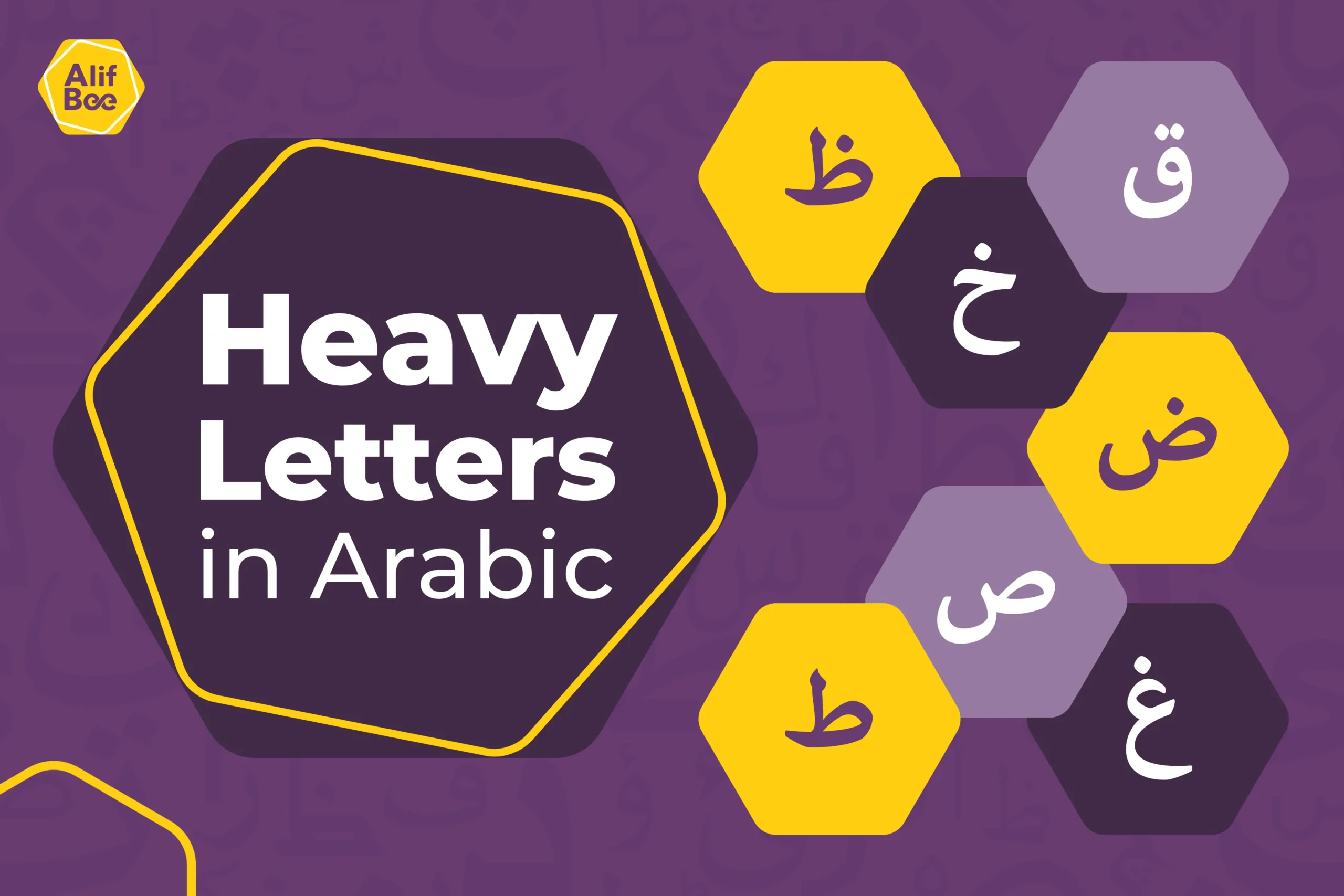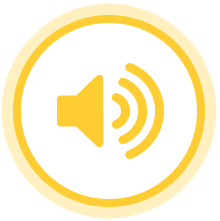

 Listen to: The 7 Heavy Letters in Arabic: A Guide to Correct Pronunciation
Listen to: The 7 Heavy Letters in Arabic: A Guide to Correct Pronunciation

Welcome back, dear Arabic learners!
This is going to be one of the most interesting and crucial articles in your journey of learning Arabic, as it will discuss what makes the Arabic language unique and distinctive.
Have you noticed that some Arabic sounds feel deep and strong while others sound light and soft?
These are called heavy Arabic letters, or tafkheem letters. An essential part of Arabic phonetics, these Arabic letters will give you a huge push in your Arabic learning path, especially in improving your Arabic pronunciation.
But before we dig deeper into each of these letters, let’s answer the crucial question.
In Arabic, and more specifically in tajweed rules, we have something called tafkheem (تَفخِيم), which means “heaviness.” Tafkheem letters in Arabic are a group of emphatic letters combined in the following mnemonic:
خص ضغط قظ (khā’, ṣād, ḍād, ghayn, ṭā’, qāf, ẓā’)
When you pronounce these heavy letters in Arabic, the back of your tongue rises towards the roof of your mouth. This action causes a sensation of fullness or heaviness in the mouth, which creates a deeper sound. Unlike light letters in Arabic or Al ḥurūf murqaqah, (softened letters), which are pronounced with the tongue lowered.
Now, let’s look at each of these heavy letters and learn their correct pronunciation and see them in examples.
Sound
Letter
Khāʼ
خ
Isolated
Initial
Medial
Final
خ
خـ
ـخـ
ـخ
The letter خ is one of Arabic’s guttural sounds, produced deep in the throat. It is similar to the German/Spanish “j” in Bach.
It’s considered an emphatic/heavy letter, which influences the quality of nearby vowels, making them sound fuller.
It’s common in names like Khalid and Khadija and in many common Arabic words that reflect everyday culture and life. Check and practice the following examples:
bread
khubz
خُبْز
steam
bukhār
بُخَار
watermelon
baṭṭykh
بِطِّيخ
Notice that the letter sounds heaviest when it’s near the letter “alif” and least heavy when it’s near the letter “yaa’”.
Sound
Letter
Ṣād
ص
Isolated
Initial
Medial
Final
ص
صـ
ـصـ
ـص
The letter ص is one of Arabic’s emphatic sounds, giving words a strong, powerful resonance. It’s like an “s” but pronounced with more depth and force, as if you’re pressing the sound from within.
Because it’s a heavy letter, it affects the vowels around it, making them sound rounder and more powerful.
It appears frequently in the Qur’an, which is why it’s often considered a “Qur’anic sound.”
You’ll hear ص in many familiar names, too, like Ṣalāḥ, Ṣafā, and Ṣādiq. It also appears in everyday words like the following words:
patience
ṣabr
صَبر
short
qaṣyr
قَصِير
thief
liṣṣ
لِصّ
Sound
Letter
Ḍād
ض
Isolated
Initial
Medial
Final
ض
ضـ
ـضـ
ـض
The letter ض is one of the most unique sounds in Arabic, so much so that Arabic is sometimes called “لُغَة الضَّاد” (lughat al-ḍād), the language of Ḍād, it’s like the symbol of the Arabic language, it’s also called “the letter of Arabic.”
It’s an emphatic, heavy sound, produced by pressing the side of the tongue against the molars, giving it a distinct thickness that doesn’t exist in most other languages.
You’ll hear ض in words like:
light
Ḍaw’
ضَوء
ablution
wuḍwʼ
وُضُوء
eggs
bayḍ
بَيض
Sound
Letter
Ghyn
غ
Isolated
Initial
Medial
Final
غ
غـ
ـغـ
ـغ
The letter غ is one of Arabic’s deep, throaty sounds, produced at the back of the mouth near the throat. It’s a rich, resonant sound, almost like a growl. It’s often compared to the French “r” as in “Paris.”
Like all heavy letters, it makes the vowels around it sound fuller and more rounded.
You’ll hear غ in names like Ghayth and Ghada, and in everyday words, like:
crow
Ghurāb
غُرَاب
parrot
Babbaghāʼ
بَبَّغاء
glue
Ṣimgh
صِمغ
Sound
Letter
Ṭāʼ
ط
Isolated
Initial
Medial
Final
ط
طـ
ـطـ
ـط
The letter ط is one of Arabic’s emphatic, heavy sounds, giving words a strong, powerful presence. It’s a heavier version of “t,” pronounced with the tongue pressed harder. It also affects the vowels around it like all heavy letters.
You’ll hear ط in names like Ṭalal and Ṭariq, and in common words that carry everyday meaning, like
The following examples:
food
Ṭa‘Ām
طَعَام
penguin
biṭryq
بِطْرِيق
simple
basyṭ
بَسِيط
Sound
Letter
Qāf
ق
Isolated
Initial
Medial
Final
ق
قـ
ـقـ
ـق
The letter ق is one of Arabic’s deepest, most emphatic sounds, produced at the very back of the mouth near the throat. It’s like a “k” but with extra depth, giving words a strong, resonant quality that feels grounded and commanding.
You’ll hear ق in names like Qasim and Qamar, and in everyday words like:
heart
qalb
قَلْب
article
maqāl
مَقَال
thunder
barq
بَرْق
In some dialects, like Egyptian and Levantine Arabic, it gets a soft makeover, substituting the letter’s heavy sound with a soft Hamza (one of the light letters in Arabic), for example turning قَلْب (qalb) into ’alb, or قَمَر (qamar) into ’amar.
Sound
Letter
Ẓāʼ
ظ
Isolated
Initial
Medial
Final
ظ
ظـ
ـظـ
ـظ
Letter Ẓāʼ (ظ) is one of the emphatics (heavy) consonants in Arabic. It’s a heavy version of ذ (dh), like “th” in that, but emphatic, with the tongue not only touching the upper teeth with the tip, but going higher and fuller with the middle of the tongue also rising up and creating a fullness in the mouth.
It is a rare sound, found mostly in Arabic.
Look at the following examples:
shadow
Ẓill
ظِلّ
clean
Naẓīf
نَظِيف
mayor
Muḥāfiẓ
مُحَافِظ
Heavy or tafkheem letters aren’t just technical details; they are the very soul of Arabic. They are part of the language’s rhythm, meaning, and identity. If you mispronounce one, you can completely change the word. Remember that heaviness is a phonetic feature, not an accent.
Think of the difference between قَلْب (qalb) heart, and كلب (kalb) dog, if you lighten the ق and say ك, which is one of the light letters in Arabic, words could easily be confused. A single slip of heaviness shifts the entire meaning.
This is why heavy letters are central to tajwīd, the sacred practice of reciting the Qur’an. Tajwīd is not just about sounding beautiful; it’s about preserving the integrity of the Qur’an as it was revealed. The heaviness of ص, ض, ط, ظ, غ, and ق gives the recitation its depth and resonance.
Here are some tips that can help you achieve the right pronunciation for heavy letters in Arabic.
Since everything can feel challenging in the beginning, we encourage you to practice these 7 Arabic heavy letters regularly. We totally understand if they feel strange at first, but your mouth and tongue will adapt with time.
Even as an Arabic speaker myself, I remember practicing Arabic heavy letters for my Tajweed Rules class. It felt impossible to nail the pronunciation at first, and I could feel the pain in the muscles in my mouth from practice, but soon I was able to pronounce them. Hearing myself reading in fus-ha with accurate heavy letters felt rewarding. This can be you too.
You can begin by checking out our detailed guides for each letter (linked above) to perfect your Arabic pronunciation; they’ll guide you step by step with more Arabic words and example sentences for each letter.
Don’t forget to download our AlifBee App, through which you can practice Arabic pronunciation with our interactive lessons.


Achieve incredible results with our platform Learn Arabic Online with AlifBee

Join AlifBee Virtual School and master Arabic at your pace — from guided coaching to interactive self-learning.

Learn Arabic faster with live, one-on-one sessions tailored to your level and goals.

Explore AlifBee’s complete range of Arabic learning books for all ages!

Learn words to talk about weather and seasons in Arabic. Learn Arabic for “spring,” “winter,” “rain,” and more. Full Arabic Lesson with Pronunciation.

Learn the most authentic ways to say Good Morning in Arabic. Basic morning greetings including modern, classical, formal, and dialect phrases, with pronunciation and cultural context.

Say Congratulations in Arabic! Learn common phrases to congratulate someone on a wedding, graduation, or any special occasion. Find the perfect Arabic phrase.

Learn how to say days of the week in Arabic (MSA & dialects) with audio. Discover real-life phrases, pronunciation, and expand your Arabic language skills.